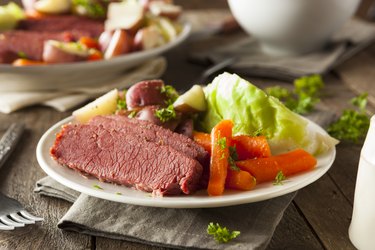
Corned beef — brisket that has been brined with salt and spices — is meaty, slightly salty and a little bit sour. The humble cut of meat can be served hot or cold, such as piled high on a sandwich with Swiss cheese, sauerkraut and Thousand Island dressing for a hunger-busting Reuben sandwich or paired with cabbage and potatoes for a traditional Sunday dinner.
Corned Beef Flat vs. Point Cut
Video of the Day
Both flat, also known as round, and point-cut beef brisket come from the lower chest, or breast, of a cow. Meat from the area above the front legs is boneless and has a strong, beefy flavor. Fresh brisket is frequently smoked, while corned beef is usually slowly braised over a low temperature in liquid.
Video of the Day
The fat is trimmed from the flat cut, while the fat is left on the point cut. Point cuts are typically more economical and may be more flavorful because of the fat.
For corned beef, cuts of brisket are cured in a mixture of water, salt, herbs and spices for a few days to a week. Commercial corned beef may contain nitrites, the chemicals that preserve the meat and give it a pink color. Corning your own beef allows you to control the ingredients.
Oven-Cooking Corned Beef
Perfectly cooked corned beef is moist and fork tender. Braising corned beef and cabbage in the oven doesn't require tons of cooking skills and isn't labor intensive.
Heat the oven to 300 degrees Fahrenheit. Place the beef in a heavy cast-iron Dutch oven fat side up and surround it with quartered cabbage, peeled and cubed potatoes, peeled and cut-up carrots and diced onion (optional). Add enough water, beef stock, vegetable stock or beer to fill the pot just to the top of the beef. Cover and cook in the oven for three hours.
At the end of three hours, test the beef for doneness. It should be tender, and the internal temperature should be 145 degrees Fahrenheit. If it's not, return it to the oven for another hour. If it is, remove the beef from the pot and let it rest for 10 to 15 minutes.
Slow-Cooker Corned Beef
There's little consensus on which is the best cut of corned beef for the slow cooker. The point cut is fattier, and fat usually translates to flavor. The flat is leaner and healthier for you. Either will turn out tender when cooked in the slow cooker.
Scatter peeled and cut-up carrots, onion, potatoes and celery on the bottom of the slow cooker. Lay the brisket fat side up on top of the vegetables. Add enough water, stock or beer to almost cover the beef. Put the lid on and cook on high for around four hours or on low for about eight hours.
Check for doneness — the meat should be tender and the internal temperature should be 145 degrees Fahrenheit. Remove the meat and let it rest for 10 to 15 minutes. Leave the vegetables in the slow cooker on low heat so they stay warm while the meat rests.
Homemade Corned Beef
Dissolve a cup of salt and 1/2 cup of sugar in 2 quarts of water. Add pickling seasonings, found in the spice section of the supermarket, or make your own with mustard seeds, peppercorns, cloves, allspice, bay leaves and juniper berries.
Place a raw beef brisket in a zipper-top bag and pour the brine over it. Seal the bag and lay it on a shelf in the fridge. Make sure the beef stays completely covered with brine. Turn the bag over once or twice a day for about a week.
Remove the meat from the bag, rinse it and cook it according to your favorite recipe.
Serving and Storing Corned Beef
Once the beef has rested, slice it against the grain. To slice the beef against the grain, note the direction that the beef fibers, or grain, run. Set your knife at an angle to the grain rather than parallel to it. If you slice with the grain, the meat will be stringy and tough.
Refrigerate cooked beef within two hours. It will keep in the fridge for three to four days and in the freezer for three to four months.